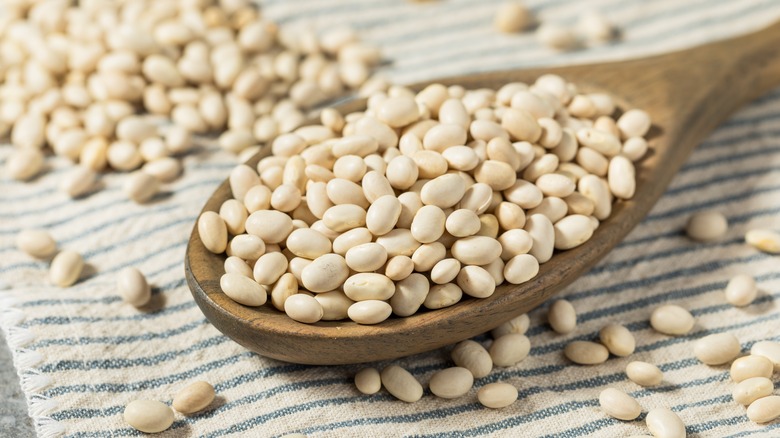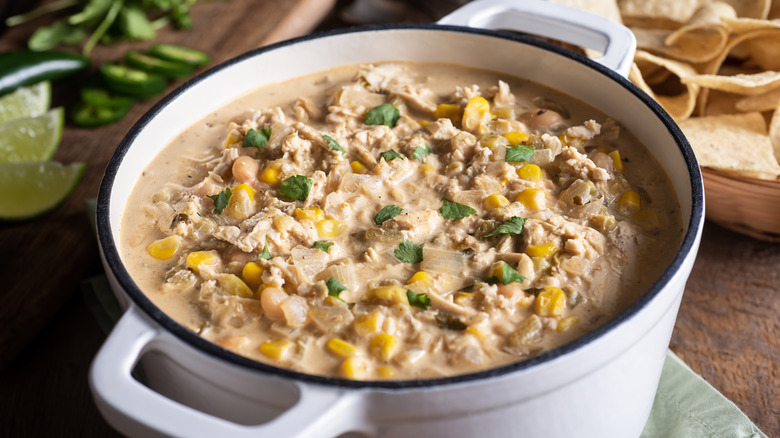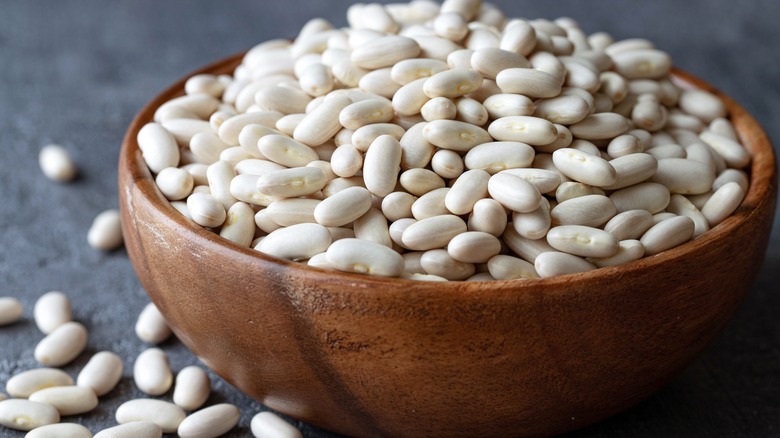Navy Beans Vs Great Northern Beans: What's The Difference?
Staring down bags and cans of white-ish, small-ish beans at the grocery store can be intimidating. You may wonder what the difference is between popular options like navy and great northern beans. After all, they look similar, and you can use both of them interchangeably to make polenta with white beans and spinach.
As you may have guessed, the answer is fairly subtle and not significant enough that it should slow down your kitchen experimentation. While a taste test may reveal you have a slight personal preference for the flavor of one or the other, for the most part, you'd probably be unable to differentiate the two when they're seasoned and prepared. They also boast a similar price and are widely available.
The biggest contrasts you might notice are when you look at them and when you take a bite. Great northerns are slightly larger and wider, looking more like a lima bean, while navy beans look more like jelly beans. You may also note a more nutty sweetness in great northerns compared to the mild navy beans. Plus, only navy beans have a signature soup befitting a Senator. They may vary slightly in terms of cook time, as well, but that depends in part on your preparation of choice — and is not a concern when using the canned version.
Differences in cooking with navy beans vs. great northern beans
Navy beans, or pea beans, are the backbone of a few famous dishes. In addition to senate bean soup, they're also frequently put to use in Boston baked beans and pork and beans, though other white varieties can do in a pinch. This is a great use for the mild legume, as it maintains a bit of firmness even after long cooks. Its small shape encourages a speedy cook according to some, though others estimate the dried ones need a lengthy hour-and-a-half to two hours to become tender on the stove, and even longer when baked low-and-slow.
Great northern beans develop more of a creaminess as they simmer, making them ideal for pairing with a protein in need of a rich, silky sauce. Many Southerners like to pair their legumes with shrimp, as its mildness allows delicate seafood to shine. Their texture is tender, so you can use them in a three bean salad or whip them into spreads. The variety is likely to take about 45 minutes to an hour or so to cook through.
Of course, the two can both stand in for recipes calling for white beans. That means anything from chilis and stews to puréed dips and toasts. Although the jury is still out on white bean blondies, you can technically incorporate them into desserts, too. Who knows, perhaps the nutty great northern bean is overdue to complement caramel and molasses without a porky sidekick.
How these legumes differ from other white beans
You'll also often see great northern and navy beans written about in comparison to other white beans, in particular cannellini beans, aka white kidney beans. This is another type of bean you should have in your pantry, and many cooks are quick to put it to use in soups, too. They're popular in Italy and you're likely to spot them in recipes for meals featuring Tuscan kale or tomatoes, like Tuscan white bean soup.
Great northern beans are often noted as a substitute for cannellini and vice versa, as they both offer a nutty flavor. And they also take about one hour to cook. The textures do vary, however, as cannellini beans are largest and have the most heft compared to both great northern and navy beans.
Another white bean that often gets lumped in with great northern and navy beans is the lima bean. No, not the fresh green ones you find in succotash, but the dried white ones. They soften and cook into deliciously creamy, brothy additions to soup, like great northerns. Limas also cook at about the same rate as their counterparts, about an hour or an hour-and-a-half. They can be slightly more vegetal in flavor compared to their mild fellow legumes, so keep this in mind if this is not to your taste.



